My test drive in a Tesla Cybertruck took a surprising turn – and it’s truly life-changing
Our EV editor has an order in for a Tesla Cybertruck. Will he still want one now he’s taken one for a drive?
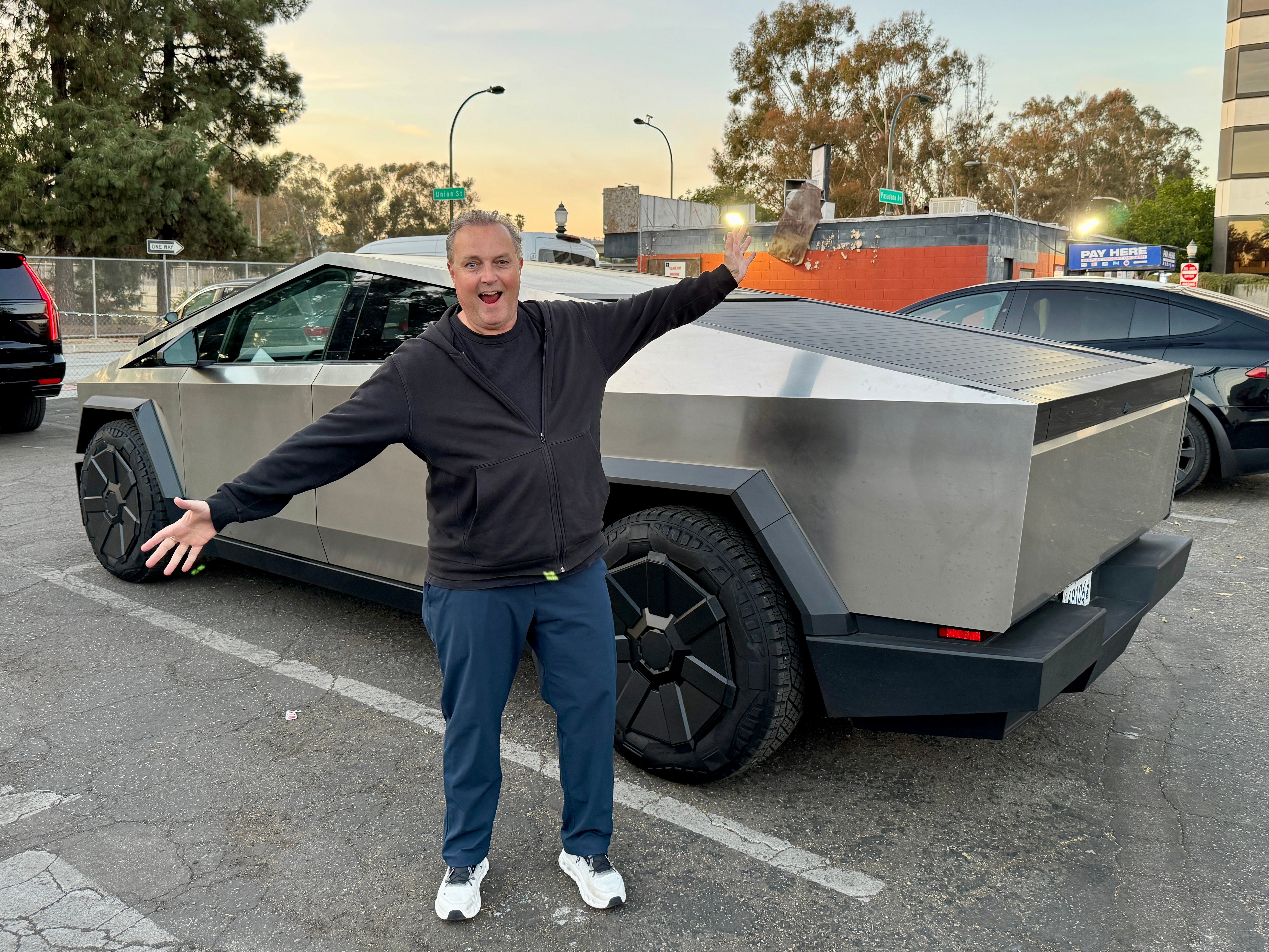
The Independent's Electric Vehicles Channel is sponsored by E.ON Next.
On the 21st November 2019, I was in Los Angeles for the LA auto show when I got a surprise call from Elon Musk’s office: would I like to go to the launch of the Cybertruck at Space X HQ? Oh, and the dress code is cyber punk.
Well, that was worth rearranging a flight for, so I donned my best mysterious black gear and went along. I was warned by a fellow punkster when I turned up that it would be unlike any car launch I’d ever been to – and it was. There were only a handful of media there, the rest of the crowd was made up of owners and fans – including some from the UK – and yes, as they had warned, middle aged men shouted out “I love you, Elon,” when the boss walked out on stage.
I remember when the car drove on and thinking that it must be a joke – a stainless steel, angular monstrosity couldn’t be the real Cybertruck, could it? It could, and it was.

It was supposed to be indestructible, until the famous sledgehammer incident that smashed the unsmashable glass. The rest is history.
I eventually went back to my hotel, still buzzing, logged on to the Tesla website and immediately put a £100 deposit on a Cybertruck. I was hooked. My order still stands to this day, although I suspect we’re no nearer to ever seeing the Cybertruck on sale on this side of the Atlantic.
Now, five years on, I’m back in LA and planning to drive a Cybertruck. Sadly, I’d left my wallet back at home with my UK driving licence in it, so despite my booking and having my international driving permit with me, Turo would not loan me a car.
Plan B. There’s a Tesla store down the road in Pasadena… Would they? Apparently, an international driving permit is just fine, so my new friend Mike closed the store, took me into the dingiest alley at the back and into a car park where a somewhat dishevelled Cybertruck was waiting for me.
My first impression, other than how dirty the stainless-steel bodywork can get with finger marks all too apparent around the doors, was that it looked smaller than before. This wasn’t going to be the challenge I thought it might be just to leave the parking lot.
Getting into the Cybertruck takes practice: there’s the usual waving of the Tesla key card at the side of the door pillar, then you must thumb an area below to release the door. If you manage it first time, you’re a genius.
Getting up into the truck (it’s not a car, remember) isn’t the exercise I was expecting, either. Air suspension will raise the Cybertruck for off-road work or lower it to get in and out – and the lowest setting makes it no worse than a large SUV to climb into.
Sitting in the Cybertruck is a tale of two halves: the front half is easy and like any other Tesla. You can’t see the end of the bonnet (or hood as Mike called it) but the windscreen is deep and the door mirrors large. Simple.
Look in the rear-view mirror and behind the spacious rear cabin is a window with a great view rearward. Behind that – like in all pick-ups – is a long load bed with a powered, retractable cover. It’s long back there – and that’s when you realise this is a near 5.7-meter-long vehicle that’s also two metres wide.
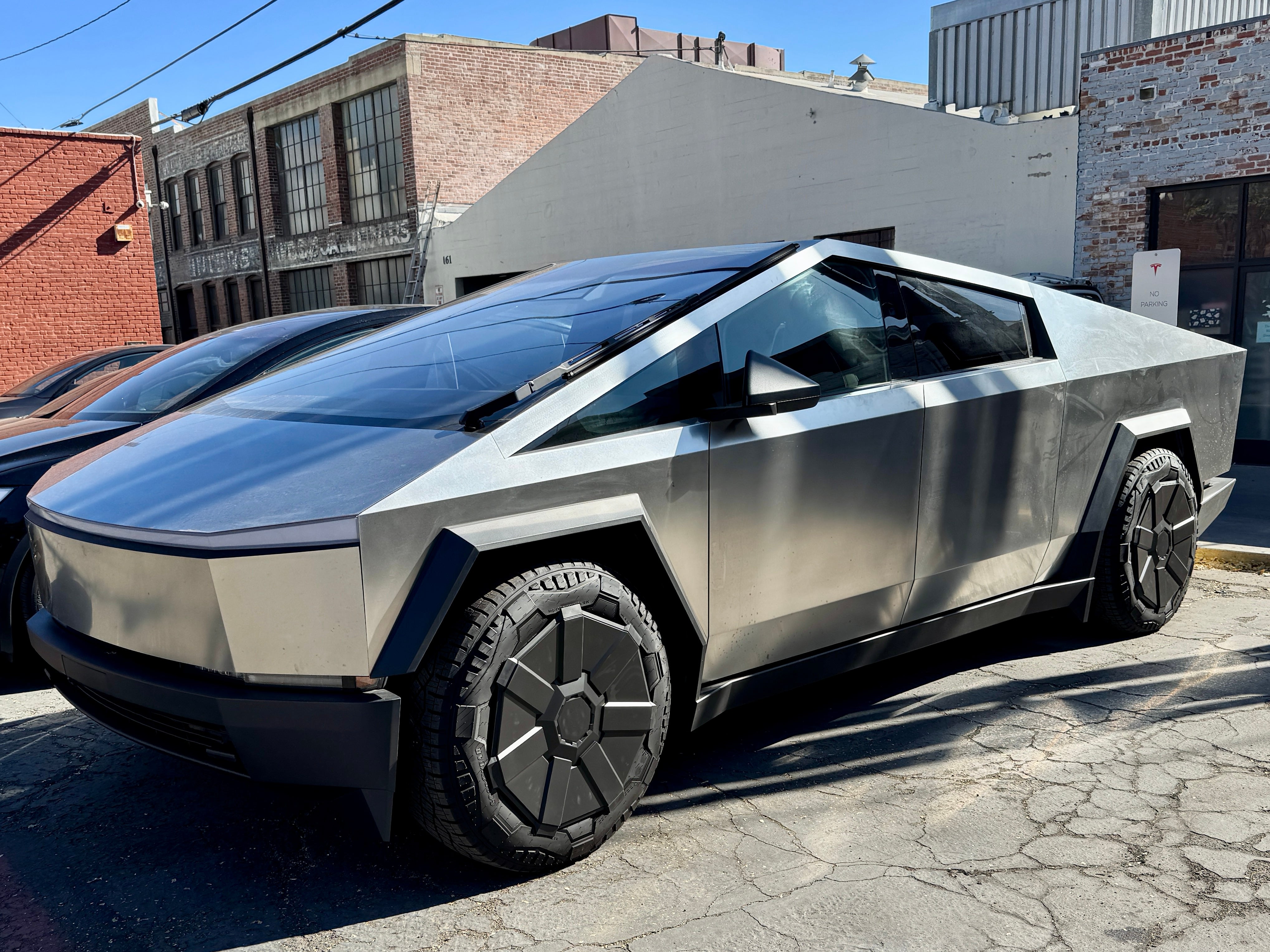
As you’d hope, there’s loads of space for five inside, with lots of storage including the usual deep bins in between the front seats, cupholders and twin wireless phone chargers. And as well as the huge pick-up bed at the back, there’s a big frunk at the front, which is accessed by the whole front of the truck – including the LED light strip – hinging upwards.
The dash looks like any other Tesla with no sign of any air vents, they’re hidden in full-width slots, while a big touchscreen sits in the middle. It’s bigger than in other Teslas at 18.5-inches but works just like the one in the new Model 3 (and like the Model 3 there’s a second screen – this time 9.4-inches – for those in the back too play with).
That means you must put your foot on the brake to power up the Cybertruck and slide a button on the touchscreen forward into drive to move off.
Oh, and there are no stalks, just like in the Model 3. Indicators are buttons on the left side of the small, rectangular steering wheel, with everything else taken care of by a combination of the touchscreen, voice control or two scroll wheels on the steering wheel.

I’ll be honest, it takes a while to get used to in the Model 3, but the Cybertruck is different, and that’s mostly due to the steering.
Before we’d got into the car, Mike had warned me about the steer-by-wire steering, which I was reassured to know had fail safes. The steering, Mike told me, was rather quick.
And so it was, with just a tiny turn of the wheel as we moved forward enough to pull the Cybertruck around the car next to it – rear-wheel steering helps to make the big truck feel far wieldier than its dimensions suggest.
The super-fast steering also means that you’re never likely to have to turn the steering more than a quarter of a turn in most manoeuvres – the joy of steer-by-wire. It also means that those indicator buttons are easier to get your head around as you’re never going to have to work out which one to press with the steering wheel upside down.
It all becomes very intuitive very quickly, and just like driving any other Tesla with a quick squirt of power you can dart in and out of traffic and up onto the freeway.

Just like any other Tesla, the ride is just about on the comfortable side of firm – less bouncy than many rival petrol-powered trucks – while there are a few creaks from around the cabin, which is another Tesla trait.
My test car is the Cybertruck All-Wheel Drive that costs $79,990 (£63,000), whizzes from 0-60mph in 4.1 seconds and claims a maximum range judged by the US EPA standard of 318 miles from the huge 123kWh battery. The only other model currently available is the Cyberbeast at $99,990 (£79,100), with three motors rather than the All-Wheel Drive’s two, meaning an increase in performance from 0-60mph in 2.6 seconds and a decrease in range to 301 miles.
Out on the freeway, my life was about to change with my first experience of Tesla’s full self-driving mode, which Mike was eager to demonstrate. Once he’d put a route into the navigation – and it was clear we were going way beyond our allotted 20-minute slot – I hit the scroll wheel and the car took over.
Officially full self-driving is still in beta and US law states that the driver must remain in control and ready to take over in a split second; the car even watches your eyes and will warn you to hold the steering wheel if you’re gaze wanders too long to the touchscreen or elsewhere.
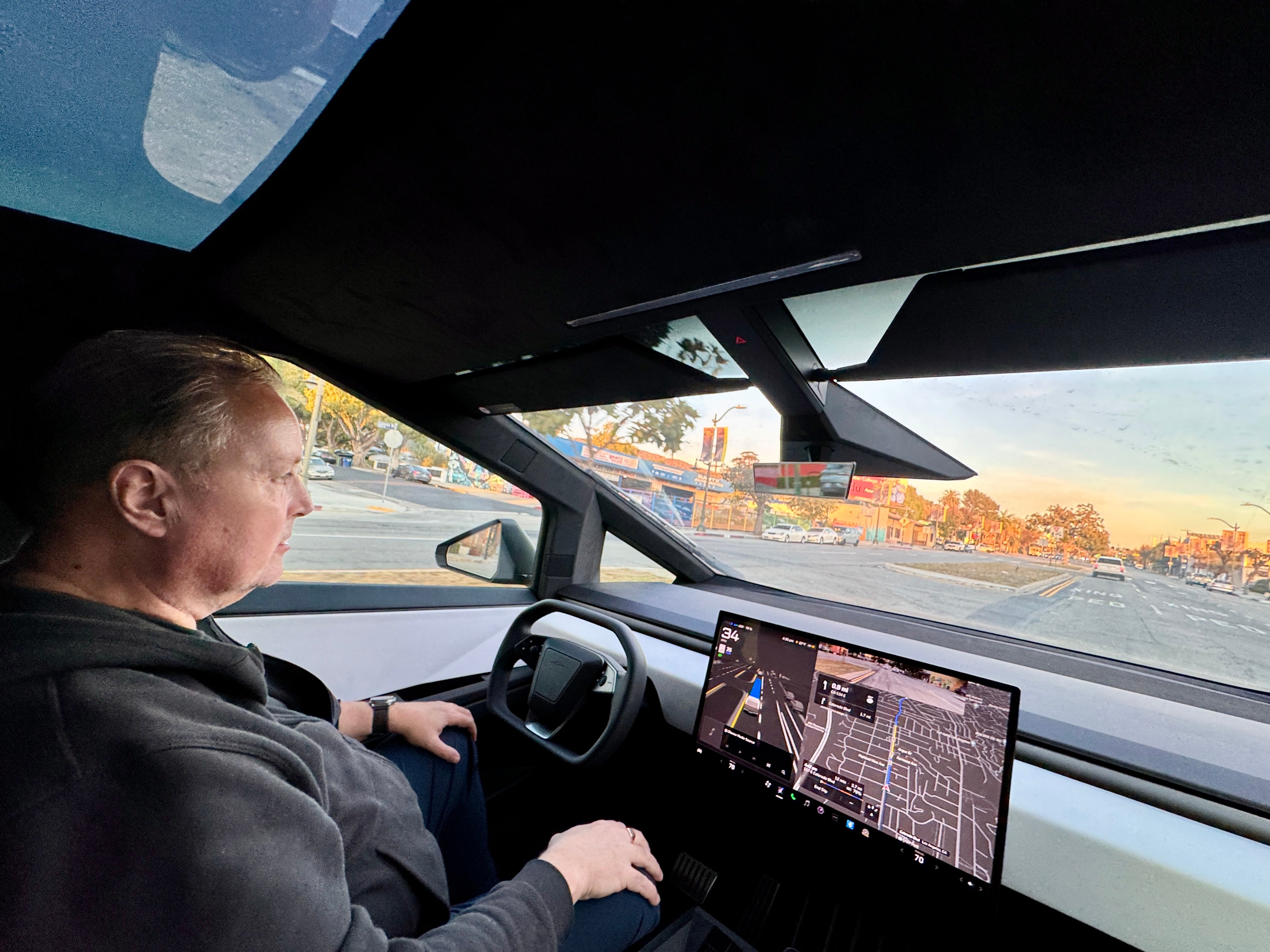
I’m a fan of adaptive cruise control where your car will stay in its lane, keep a set distance from the car in front doing the steering and braking for you and changing lanes on some cars. That’s about as autonomous as you can get in the UK these days.
Full self-driving is another level, allowing the Cybertruck to do all that on the freeway plus it will take the exit, slow down, stop at the stop sign, indicate, and turn across the traffic when there’s an appropriate space.
We’re now cruising through Pasadena, stopping at red lights, automatically starting again, ebbing and flowing with the rest of the traffic and taking turns after instruction from the navigation system.
Then we move into a left-hand lane, stop again at the traffic lights, move off on green to go across a lane of oncoming traffic, speed up as we go around a bend, indicate and merge onto another freeway. But the Cybertruck doesn’t just want to stay in the inside lane, it indicates and pulls into the next lane when it spots a gap, using the Tesla’s acceleration to good effect.
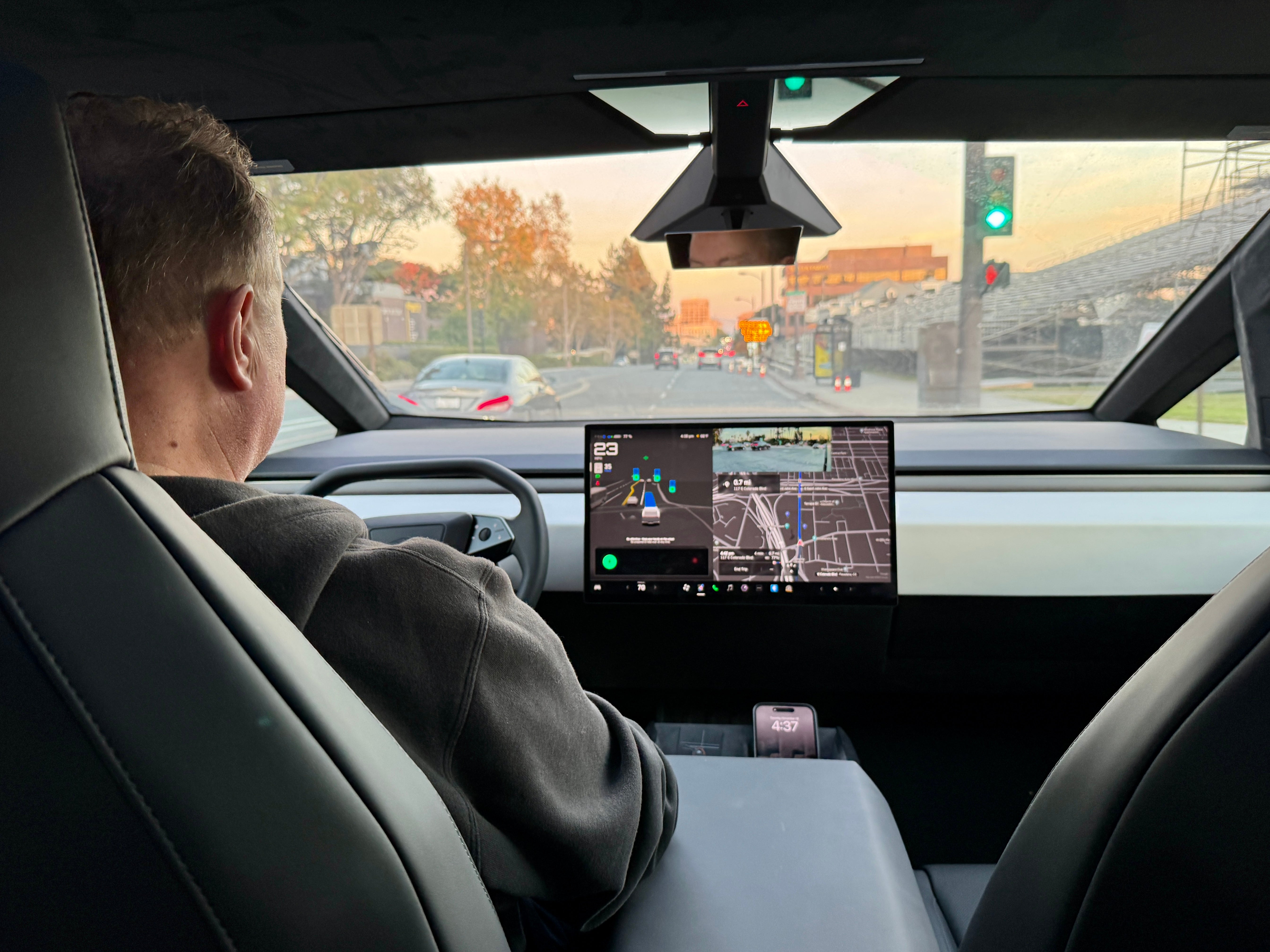
Off the freeway again at the next off-ramp, which Mike said the Cybertruck didn’t do last time he was there – it’s learning and updating all the time – through some more traffic and, eventually, back to the parking lot at the back of the Tesla store where I must take over to park up. Again, that rear-wheel steering makes it easy to get around some tight spaces. It was nice to know I still had a role – although further updates are likely to park the car, too. And there was I thinking it was me who was supposed to be taking the test drive, not the car.
So, how did I feel with Tesla’s full self-driving doing the work? I’d be lying if I didn’t say I was a bit nervous at first, but eventually I just sat there open-mouthed at the incredible experience that worked seamlessly. It is fantastic.
Of course, Elon Musk’s vision is that Tesla will make Robotaxis and Robovans to transport people around eventually, while owners’ Cybertrucks and Tesla cars will also have full self-drive capability and can be put to work when the owners aren’t using them.
Having experienced full self-driving for the first time it doesn’t feel that far off. As Mike said, it’s learning and improving all the time, and already can take the edge off tiring and tedious drives.
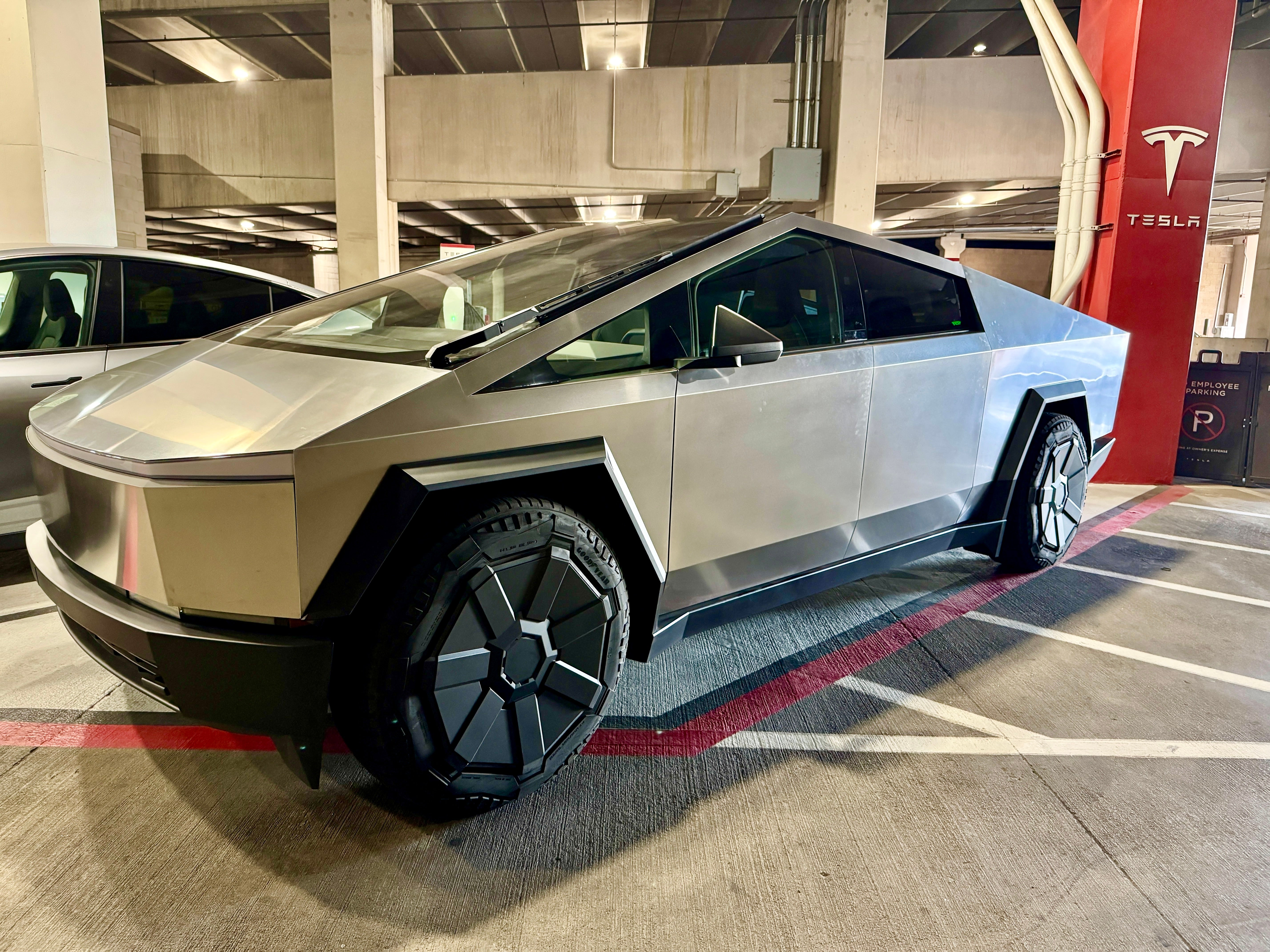
That doesn’t mean the Cybertruck isn’t an experience to drive. It’s another Tesla that just makes you smile, from the way it looks, the technology inside and the way it drives.
In fact, I loved it so much that when I was staying with my US folks in Scottsdale, Arizona a few days later, we took another test drive and they were so impressed there could be another Cybertruck order in the offing.
I’ve no pretensions about the Cybertruck coming to the UK and my deposit coming good. As much as the Cybertruck feels at home on the US streets, its size will make it tricky in the UK – it’s bigger than a Range Rover. But if I lived in the US and I had the money, I’d have a Cybertruck in a heartbeat. It made me smile, and cars that make you smile are still a very good thing.
Join our commenting forum
Join thought-provoking conversations, follow other Independent readers and see their replies
Comments